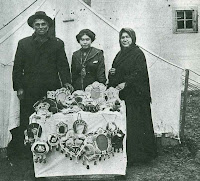 During Victorian times, it was considered civilized and necessary to keep a neat and tidy home, with a place for everything... even the whiskbroom. This artifact is a beaded Whiskbroom Holder and Victorian era souvenir. This Holder is a variation on the common decorative wall-pocket used to organize everything from fireplace matches to pocketwatches. The black and white example below spells out the purpose of the decoration and shows that this trend lasted more than just a couple years!
During Victorian times, it was considered civilized and necessary to keep a neat and tidy home, with a place for everything... even the whiskbroom. This artifact is a beaded Whiskbroom Holder and Victorian era souvenir. This Holder is a variation on the common decorative wall-pocket used to organize everything from fireplace matches to pocketwatches. The black and white example below spells out the purpose of the decoration and shows that this trend lasted more than just a couple years!
What is the Whiskbroom Holder made of?
It includes cloth, stiff backing, cloth thread, sequins, and glass beads (clear, yellow, green, black, amber). It has the date "1905" stitched in beading on the bottom panel. All beads have been hand-stitched onto the cloth backing.

Where did it come from?
This Whiskbroom Holder was likely bought as a souvenir, possibly at Niagra Falls, which drew an increasing number of tourists as the first State Park in Victorian times. Iroquois Native Americans' regularly set up craft sales tables around this tourist spot because of the large customer base wanting to comemmorate their experience with souvenirs. The Iroquois relied on basketry and beaded craft sales to support their families during the early 1900s. Their original land had been redistributed to White settlers in Canada and the Northeasten U.S., forcing them to adopt the ways of city life and a money economy. Below, Iroquois women do beadwork in their Brooklyn home. The White tourists insisted on romanticizing that the Native American beaders led "natural" lifestyles, so that their souvenirs seemed all the more exotic.


...Pretty Trinkets Put to Work...
This Whiskbroom Holder demonstrates a shift in the purpose of souvenirs from the 18 and 19th centuries' "curiosity to gaze upon" to the 20th century "useful souvenir." Because of the new trend at the turn of the century to use or wear souvenirs, many of these objects were used until the point of deterioration, leaving few behind which are in excellent condition. Besides whiskbroom holders, Native American craft tables around Saratoga Springs, Niagara Falls, and Montreal supplied the high demand for beaded pincushions, boxes, purses, sewing bags, and picture frames.

Souvenirs in Wood County
Well-to-do Wood County residents had the most opportunity to visit places like Niagara Falls; therefore, most hand-made souvenirs of this type were used in wealthy homes (unless given as a gift to a working-class acquaintence). This Whiskbroom Holder shows that families of Wood County traveled to Northeastern destinations for vacationing, and that there was direct interaction with Native American craftspersons during the first decade of the 1900s.
The Whiskbroom Holder is in storage with other historic textiles in the Collections West Storage Attic at the Wood County Historical Center. The West Storage attic is kept cool and dark to preserve all artifacts in storage.
Resources used for this post include:
Phillips, Ruth B. Trading Identities: The Souvenir in Native North American Art from the Northeast, 1700-1900. University of Washington Press: Seattle, WA. 1998.
Shuman, John A. III. Warman's Native American Collectibles: A Price Guide and Historical Reference. Krause Publications: Iola, WI. 1998.
No comments:
Post a Comment